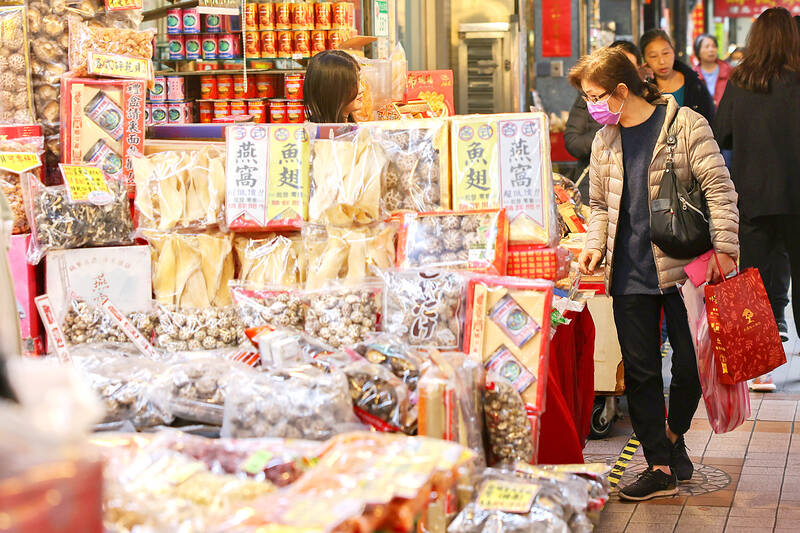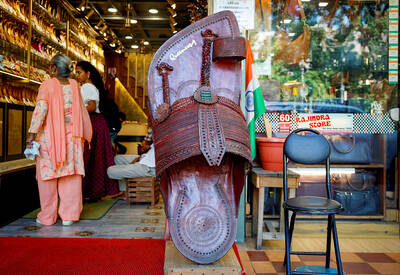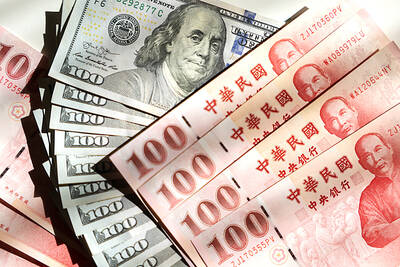The consumer price index (CPI) for last month stood at 1.79 percent from a year earlier, dropping below the central bank’s 2 percent target as goods and services grew more expensive but at a mild pace, the Directorate-General of Budget, Accounting and Statistics (DGBAS) said yesterday.
The inflation reading represented the lowest in seven months, but the statistics agency attributed the slowdown mainly to the timing of the Lunar New Year, which fell in January last year, making for a higher comparison base.
The CPI would have logged 2.4 percent in the absence of the holiday distortion, DGBAS official Tsao Chih-hung (曹志弘) said, suggesting that inflationary pressure could gain momentum this month when commercial establishments traditionally raise food and services charges to meet a pickup in demand over the Lunar New Year.

Photo: CNA
“People might feel the pinch more acutely,” since food costs, the largest chunk making up the index and an expense all consumers need to bear, advanced 4.1 percent, Tsao said.
Fruit prices spiked 20.86 percent due to lingering disruptions from inclement weather, the official said. Meat prices were up 5.63 percent, while processed food items and dining out costs rose 4.31 percent and 4 percent each.
By contrast, vegetable prices tumbled 14.54 percent year-on-year, as ample supply weighed on their value and helped mitigate overall food costs, Tsao said.
Core CPI, a more reliable long-term price tracker because it strips volatile items, increased 1.64 percent, also well inside 2 percent territory, DGBAS data showed.
Healthcare expenses advanced 3.12 percent on the back of copayment, treatment and drug price hikes, it said.
Garment prices climbed 2.47 percent ahead of the holiday, while shelter costs grew a moderate 1.75 percent, propelled by continued increases in home repair, rent and electricity charges, the official said.
Transportation and communications expenses inched up 0.51 percent and miscellaneous items squeezed a 0.3 percent rise, thanks to cheaper public transportation pass charges, as well as the favorable holiday effect, Tsao said.
Education and entertainment costs, the main inflation drivers in the post-pandemic era, both remained low last month due to the holiday timing, but might stage a noticeable comeback later this month, the official said.
Economists have said it is better to average the CPI data of the first two months to gain a better understanding of inflation trends and factor in holiday disruptions.
Tsao said it is unlikely that the reading would slow below the 2 percent threshold.
The producer price index, which measures price changes from a seller’s viewpoint, declined 0.46 percent, stagnant from a revised 0.47 percent retreat seen one month earlier, DGBAS said.
Raw material, mineral and basic metal product prices weakened further as end-market demand remained soft, it said.

MARKET LEADERSHIP: Investors are flocking to Nvidia, drawn by the company’s long-term fundamntals, dominant position in the AI sector, and pricing and margin power Two years after Nvidia Corp made history by becoming the first chipmaker to achieve a US$1 trillion market capitalization, an even more remarkable milestone is within its grasp: becoming the first company to reach US$4 trillion. After the emergence of China’s DeepSeek (深度求索) sent the stock plunging earlier this year and stoked concerns that outlays on artificial intelligence (AI) infrastructure were set to slow, Nvidia shares have rallied back to a record. The company’s biggest customers remain full steam ahead on spending, much of which is flowing to its computing systems. Microsoft Corp, Meta Platforms Inc, Amazon.com Inc and Alphabet Inc are

Luxury fashion powerhouse Prada SpA has acknowledged the ancient Indian roots of its new sandal design after the debut of the open-toe footwear sparked a furor among Indian artisans and politicians thousands of miles from the catwalk in Italy. Images from Prada’s fashion show in Milan last weekend showed models wearing leather sandals with a braided design that resembled handmade Kolhapuri slippers with designs dating back to the 12th century. A wave of criticism in the media and from lawmakers followed over the Italian brand’s lack of public acknowledgement of the Indian sandal design, which is named after a city in the

The US overtaking China as Taiwan’s top export destination could boost industrial development and wage growth, given the US is a high-income economy, an economist said yesterday. However, Taiwan still needs to diversify its export markets due to the unpredictability of US President Donald Trump’s administration, said Chiou Jiunn-rong (邱俊榮), an economics professor at National Central University. Taiwan’s exports soared to a record US$51.74 billion last month, driven by strong demand for artificial intelligence (AI) products and continued orders, with information and communication technology (ICT) and audio/video products leading all sectors. The US reclaimed its position as Taiwan’s top export market, accounting for

INVESTOR RESILIENCE? An analyst said that despite near-term pressures, foreign investors tend to view NT dollar strength as a positive signal for valuation multiples Morgan Stanley has flagged a potential 10 percent revenue decline for Taiwan’s tech hardware sector this year, as a sharp appreciation of the New Taiwan dollar begins to dent the earnings power of major exporters. In what appears to be the first such warning from a major foreign brokerage, the US investment bank said the currency’s strength — fueled by foreign capital inflows and expectations of US interest rate cuts — is compressing profit margins for manufacturers with heavy exposure to US dollar-denominated revenues. The local currency has surged about 10 percent against the greenback over the past quarter and yesterday breached